To this point in the series, we have mostly used major and minor scales to solo over chords diatonic to the key center of the scale, while emphasizing the arpeggio notes to make them stand out.
And while it’s important to use notes that fit, or blend well, with the chord you are soloing over — the arpeggio notes and notes from the chord’s key center — using only chord tones and scale tones can become monotonous and unnecessarily limiting.
It’s also important to incorporate notes that are outside of a chord’s key center — called chromatic notes — into your solos, notes drawn from the chromatic scale.
This post will cover how to construct a chromatic scale. It will also provide some common fingerings for the scale, along with instruction on how to play them on a guitar starting on any note.
Lastly, it will provide some common strategies for incorporating chromatic notes into your solos.
The Chromatic Scale: Theory
The chromatic scale is a 12-note scale, with a half step between each of the notes. The scale contains all 12 notes used in Western music, the seven natural notes and the five half-step alterations between them.
There is only one chromatic scale. It’s atonal, having no primary note of emphasis or focus, and it can start and end on any note.
Ascending Chromatic Scale
The chromatic scale shown in fig.1 starts on a C and ascends to the C an octave higher. When the chromatic scale ascends, sharps are used to indicate the altered notes.
Fig.1

Descending Chromatic Scale
The chromatic scale shown in fig.2 starts on C and descends to the C an octave lower. When the chromatic scale descends, flats are used to indicate the altered notes.
Fig.2

The Chromatic Scale: On a Guitar
The chromatic scale can be played across all six strings on a guitar or on any single string, up and down the fretboard.
Across the Strings, Ascending
Fig.3 shows a common, two octave fingering for an ascending chromatic scale.
Fig.3
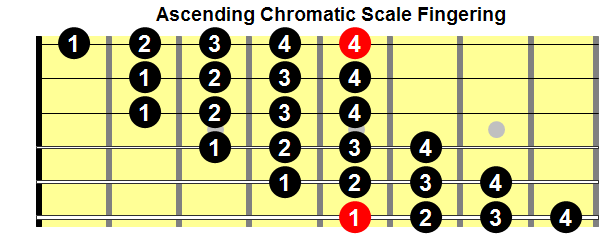
This fingering will allow you to play an ascending chromatic scale starting on any note.
To play an ascending chromatic scale starting on C, start the pattern on the sixth string, eighth fret (fig.4).
Fig.4
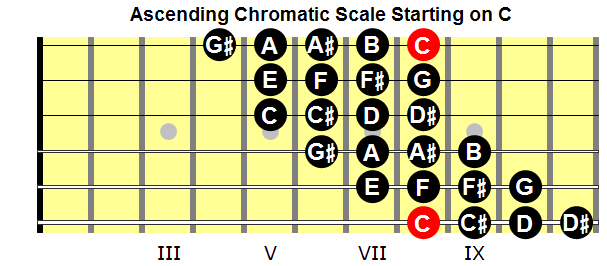
Across the Strings, Descending
Fig.5 shows a common, two octave fingering for a descending chromatic scale.
Fig.5

This fingering will allow you to play a descending chromatic scale starting on any note.
To play a descending chromatic scale starting on C, start the pattern on the first string, eighth fret (fig.6).
Fig.6

On a Single String, Ascending
Fig.7 shows a common single-string fingering for an ascending chromatic scale.
Fig.7
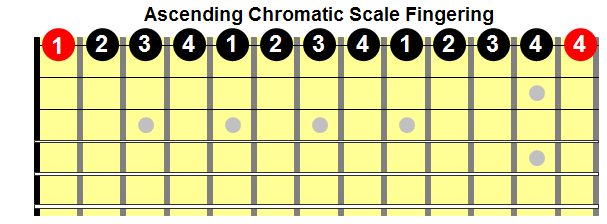
This fingering will allow you to play an ascending chromatic scale starting on any note.
To play an ascending chromatic scale starting on C, start the pattern with your first finger on the second string, first fret (fig.8).
Fig.8
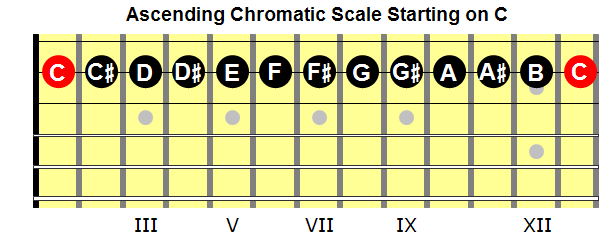
On a Single String, Descending
Fig.9 shows a common fingering for a descending chromatic scale.
Fig.9
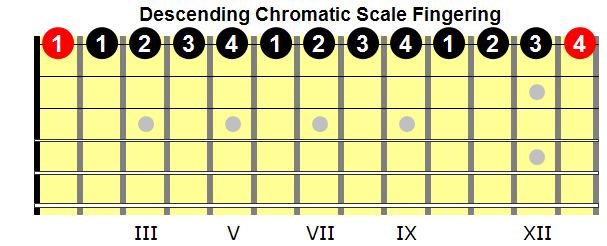
This fingering will allow you to play a descending chromatic scale starting on any note.
To play a descending chromatic scale starting on C, start the pattern with your fourth finger on the second string, 13th fret (fig.10).
Fig.10
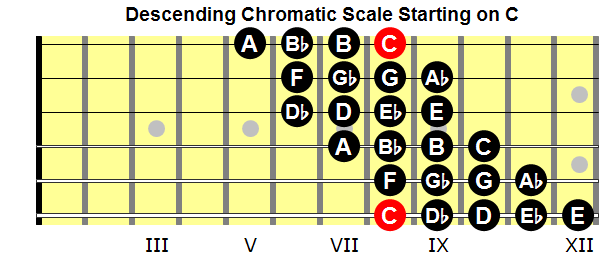
Chromatic Definition
The term chromatic has two meanings in music:
- It can mean movement in half steps.
- It can mean non-diatonic (outside the key center).
The first meaning of chromatic refers to the chromatic scale’s structure. It’s constructed with entirely half steps. Any melodic or harmonic movement in half steps is referred to as chromatic.
The second meaning of chromatic refers to those notes that fall outside of the key center of the music. And it’s those chromatic notes that we want to incorporate into our playing to add color and create tension in our solos.
Soloing with the Chromatic Scale
The chromatic scale itself isn’t used to solo over any specific chord or chords. It’s atonal, having no single note of focus or emphasis.
But the scale contains every note used in music, so it includes all of the notes not contained in any given diatonic scale or arpeggio. And those chromatic notes — the “out” notes — if handled carefully, can be used to solo over any chord, in any key.
The chromatic notes will add color and variety to your solos, but being outside of the key center and outside of the harmonic structure of the chords, they will clash with the chords you are soloing over, creating dissonance or tension.
And this tension needs to be resolved by moving to the nearest chord tone or scale tone, preferably a half step away.
Incorporate Chromatic Notes into Your Solos
There are many ways to incorporate chromatic notes into your solos and most of them involve tying them to scale tones or chord tones (the “in” notes).
Here are a few of the most common ways to incorporate chromatic notes into your solos.
Passing Tones
A passing tone is a chromatic note, played between two different scale tones and/or chord tones, all three notes being a half step apart. In other words, the passing tone connects two different scale tones and/or chord tones chromatically.
You can insert a passing tone into any phrase or scale run, adding smoothness to the line.
Neighbor Tones
A neighbor tone is a chromatic note, located a half step above or below a chord tone or scale tone:
- An upper neighbor is located a half step above a chord tone or scale tone.
- A lower neighbor is located a half step below a chord tone or scale tone.
The most common way to use a neighbor tone is to:
- Play a scale tone or chord tone.
- Play the chromatic note located a half step above or below it.
- Return to the original scale or chord tone.
The neighbor tone serves to embellish the scale tone or chord tone.
Targeting
You can also use a neighbor tone to target (or set up) a chord tone. Preceding an important chord tone with a chromatic note — a half step above or below it — creates tension and anticipation for the chord tone.
An effective way to emphasize a chord change is by playing a chord tone on a strong beat and a neighbor tone immediately before it.
Chromatic Note Groups
Entire note groups can also be moved chromatically. You can play the same phrase, run or repetitive pattern in consecutive half steps, up or down the fretboard.
Just be certain to land on a chord tone to resolve the tension created by the chromatic movement.
Caveat
It’s important to remember that chromatic notes are outside of the key center and the harmonic structure of the chords you are soloing over and they will clash with the chords.
The longer you sustain a chromatic note without resolving it, the more likely it will just sound wrong, like you made a mistake.
Always resolve the tension created by a chromatic note by moving to the nearest chord tone, preferably a half step away.
